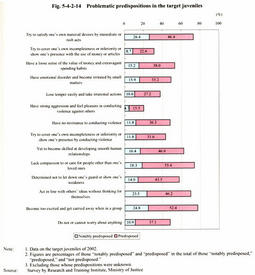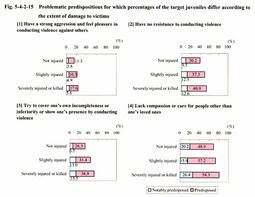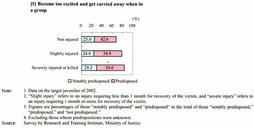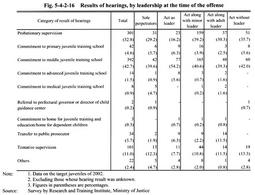| Previous Next Index Image Index Year Selection | |
|
|
4 Analysis of characteristics of predispositions Juvenile classification homes conduct classification on the predisposition of juveniles with the aim of contributing to juvenile hearings at family courts and enforcement of protective measures. Fig. 5-4-2-14 shows the summary of problematic predispositions of the target juvenile robbery offenders, which have been identified in the classification procedures with respect to the delinquent acts concerned. The percentages of the target juveniles who "become too excited and get carried away when in a group," "lack compassion or care for people other than their loved ones," and "try to satisfy their own material desires by immediate or rash acts" exceed 70% respectively and the percentage of those who "act in line with others' ideas without thinking for themselves" comes to nearly 70%. This indicates that the majority of juvenile robbery offenders act according to their mood and have difficulty carefully choosing their behavior when in a group; they do not think about people other than those who are familiar to themselves, and they tend to try to satisfy their own material desires occasionally by whatever means, whether legal or illegal. With respect to the problematic predisposition relating to violence, the percentage of the target juveniles who "have no resistance to conducting violence" comes to nearly 50%. However, with respect to the problematic predisposition of "having strong aggression and feeling pleasure in conducting violence against others," the percentage of the target juveniles who are "notably predisposed" is extremely small at 4.7% and the percentage of those who are "notably predisposed " and those who are "predisposed" collectively only reaches 20.2%, which indicates that the share of juveniles who have such extreme aggression and feel pleasure in conducting violence is relatively small.
Fig. 5-4-2-14 Problematic predispositions in the target juveniles Fig. 5-4-2-15 shows problematic predispositions for which the percentages of the target juveniles differ according to the extent of damage to victims. This indicates that the number of the target juveniles who have problematic predispositions relating to violence increases as the extent of damage to victims becomes more serious. In particular, the total percentage of the target juveniles who are "notably predisposed" and those who are "predisposed" to "try to cover one's own incompleteness or inferiority or show one's presence by conducting violence" increases clearly as the extent of damage becomes more serious, 32.8% among those who have "not injured" victims, 44.4% among those who have "slightly injured" victims, and 52.4% among those who have "severely injured/killed" victims. On the other hand, the target juveniles who "have strong aggression and feel pleasure in conducting violence against others" only account for slightly over 20% among those who have severely injured/killed victims. Furthermore, the problematic predisposition of "becoming too excited and getting carried away when in a group" is closely related to the extent of damage to victims. More specifically, when juveniles become too excited and get carried away with accomplices, they conduct more violent acts and finally cause more serious damage to victims.Fig. 5-4-2-15 Problematic predispositions for which percentages of the target juveniles differ according to the extent of damage to victims Analysis of the relationship between the matters of principal concern at the time of the offense and the problematic predispositions has revealed the following matters. Among the target juveniles whose matters of principal concern was "maintaining the relationship with accomplices," the percentages of those who act according to their mood and have difficulty in carefully choosing their behavior when in a group and of those who have problems in developing relationships with others are large whereas the percentages of those who have other problematic predispositions are relatively small. Among the target juveniles whose matters of principal concern was "conducting violence against victims," the percentages of those who have an affinity to conducting violence and of those who do not think about people other than people they know are large. Among the target juveniles whose matters of principal concern was "taking money or articles," the percentages of those who have a loose sense of the value of money and try to satisfy their own material desires occasionally and of those who do not think about people other than people they know are large whereas the percentage of those who have an affinity to conducting violence is small.Table 5-4-2-16 shows the results of hearings for juvenile robbery offenders; almost half of them were committed to juvenile training schools. The distribution of the results of hearings for juvenile robbery offenders differ according to whether they acted as leader at the time of the offense, and the rates of those committed to juvenile training schools and those transferred to public prosecutors are high among the target juveniles who acted as leader. According to the results of hearings, juveniles are treated at applicable institutions with the aim of correcting their own problems. For details of such treatment, see Chapter 6, Section 4 . Table 5-4-2-16 Results of hearings, by leadership at the time of the offense |



